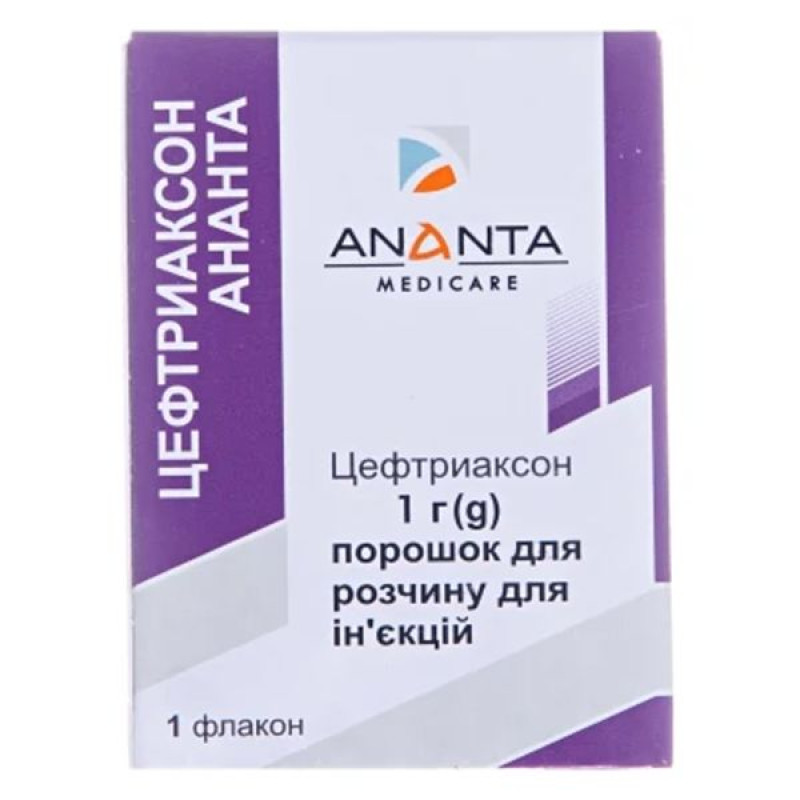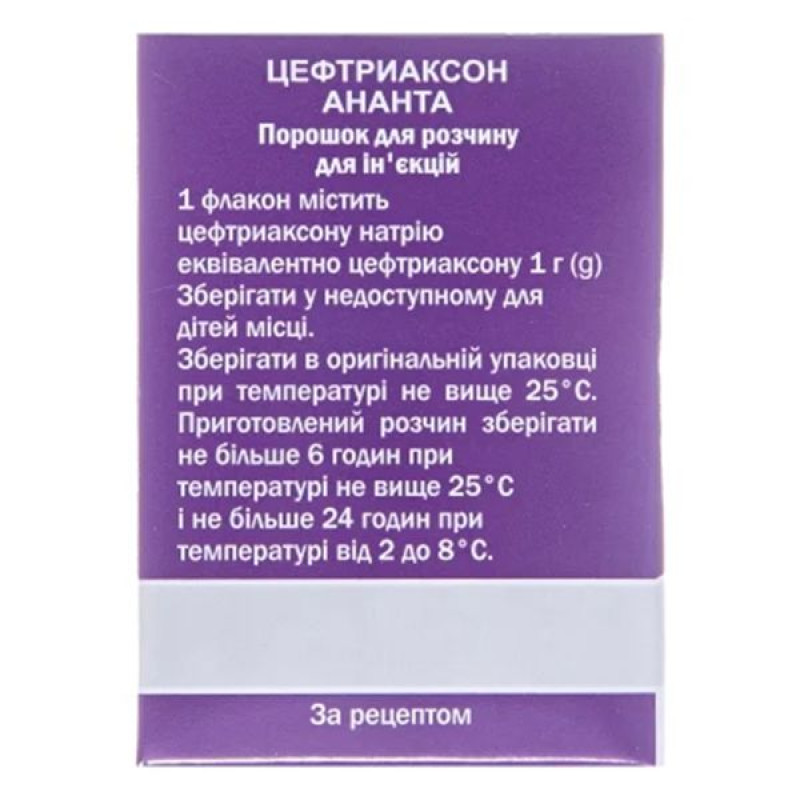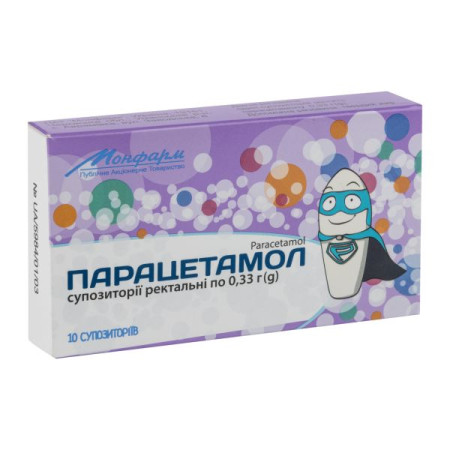Ceftriaxone-Ananta 1g No. 1

Powder for solution for injection "Ceftriaxone Ananta" is used to treat the following infections in adults and children, including full-term newborns (from birth):
bacterial meningitis; community-acquired pneumonia; hospital-acquired pneumonia; acute otitis media; intra-abdominal infections; complicated urinary tract infections (including pyelonephritis); bone and joint infections; complicated skin and soft tissue infections; gonorrhea; syphilis; bacterial endocarditis."Ceftriaxone Ananta" can be used for:
treatment of acute complications of chronic obstructive pulmonary disease in adults; treatment of disseminated Lyme disease (early (stage II) and late (stage III)) in adults and children, including newborns aged 15 days and older; preoperative prophylaxis of infections at the surgical site; management of neutropenic patients who have developed fever with suspected bacterial infection; treatment of patients with bacteremia associated with any of the above infections or if any of the above infections are suspected."Ceftriaxone Ananta" should be prescribed together with other antibacterial drugs if the possible range of bacterial pathogens does not fall within the spectrum of action of ceftriaxone.
Official recommendations on the appropriate use of antibacterial agents should be taken into account.
Composition
The active substance is ceftriaxone (1 vial contains ceftriaxone sodium equivalent to ceftriaxone 1 g).
Contraindication
Hypersensitivity to ceftriaxone or any other cephalosporin. History of severe hypersensitivity reactions (e.g. anaphylactic reactions) to any other type of β-lactam antibacterial agent (penicillins, monobactams and carbapenems).
Ceftriaxone is contraindicated:
premature newborns aged ≤ 41 weeks taking into account the term of intrauterine development (gestational age + age after birth); full-term newborns (aged ≤ 28 days): with hyperbilirubinemia, jaundice, hypoalbuminemia or acidosis, since in such conditions bilirubin binding is likely to be impaired; require (or are expected to require) intravenous administration of calcium preparations or infusions containing calcium, solutions, since there is a risk of precipitation of the calcium salt of ceftriaxone.Before intramuscular administration of ceftriaxone, it is necessary to exclude the presence of contraindications to the use of lidocaine, if it is used as a solvent.
Ceftriaxone solutions containing lidocaine should never be administered intravenously.
Method of application
The dose of the drug depends on the severity, sensitivity, location and type of infection, as well as the patient's age and liver and kidney function.
The following are recommended doses for indications. In particularly severe cases, a higher dose from the recommended range should be used.
Adults and children over 12 years of age (≥ 50 kg)
Community-acquired pneumonia, acute complication of chronic obstructive pulmonary disease, intra-abdominal infections, complicated urinary tract infections (including pyelonephritis) - 1-2 g once a day.
Hospital-acquired pneumonia, complicated skin and soft tissue infections, bone and joint infections - 2 g once a day.
Management of patients with neutropenia (who have developed fever and are suspected of having a bacterial infection), bacterial endocarditis, bacterial meningitis - 2-4 g once a day.
Newborns, infants and children aged 15 days to 12 years (< 50 kg)
Children weighing 50 kg or more should use the usual adult doses.
Intra-abdominal infections, complicated urinary tract infections (including pyelonephritis), community-acquired pneumonia, hospital-acquired pneumonia - 50-80 mg/kg once a day.
Complicated skin and soft tissue infections, bone and joint infections, management of patients with neutropenia (who have developed fever and are suspected of having a bacterial infection) - 50-100 mg/kg (maximum - 4 g) once a day.
Bacterial meningitis - 80-100 mg/kg (maximum - 4 g) once a day.
Bacterial endocarditis - 100 mg/kg (maximum - 4 g) once a day.
Newborns 0-14 days
"Ceftriaxone Ananta" is contraindicated in premature newborns from postmenstrual age to 41 weeks (gestational age + calendar age).
Ceftriaxone is contraindicated in premature infants up to 41 weeks, taking into account the term of intrauterine development (gestational age + age after birth).
Intra-abdominal infections, complicated skin and soft tissue infections, complicated urinary tract infections (including pyelonephritis), community-acquired pneumonia, hospital-acquired pneumonia, bone and joint infections, management of neutropenic patients (who have developed fever and are suspected of having a bacterial infection) - 20-50 mg/kg once daily.
Bacterial meningitis, bacterial endocarditis - 50 mg/kg once a day.
The maximum daily dose of 50 mg/kg should not be exceeded.
An introductory part of the instructions is provided, read the full instructions inside the package.
Application features
Pregnant women
Ceftriaxone is excreted in breast milk in low concentrations, but no effects on the breastfed infant are expected at therapeutic doses. However, the risk of diarrhoea and fungal infections of the mucous membranes cannot be excluded. The possibility of sensitization should be considered. A decision must be made whether to discontinue breast-feeding or to discontinue/abstain from ceftriaxone therapy taking into account the benefit of breast-feeding for the child and the benefit of therapy for the woman.
Reproductive studies have shown no evidence of adverse effects on male or female fertility.
Drivers
During treatment with ceftriaxone, side effects such as dizziness may occur, which may affect the ability to drive or operate machinery. Patients should be careful when driving or operating machinery.
Overdose
Overdose may cause nausea, vomiting, diarrhea. In case of overdose, hemodialysis or peritoneal dialysis will not reduce excessive plasma drug concentrations. There is no specific antidote. Treatment of overdose is symptomatic.
Side effects
The most common adverse reactions observed with ceftriaxone are eosinophilia, leukopenia, thrombocytopenia, diarrhea, rash, and elevated liver enzymes.
Interaction
Ceftriaxone is incompatible with amsacrine, vancomycin, fluconazole and aminoglycosides. Ceftriaxone should not be mixed with calcium-containing solutions such as Ringer's solution or Hartmann's solution, as precipitates may form. Ceftriaxone should not be mixed or administered simultaneously with calcium-containing solutions, including parenteral nutrition solutions.
Storage conditions
Store in the original packaging at a temperature not exceeding 25 °C, out of the reach of children.
Store the prepared solution for no more than 6 hours at a temperature not exceeding 25 °C and for no more than 24 hours at a temperature from 2 °C to 8 °C.
Shelf life - 2 years.
There are no reviews for this product.
There are no reviews for this product, be the first to leave your review.
No questions about this product, be the first and ask your question.








